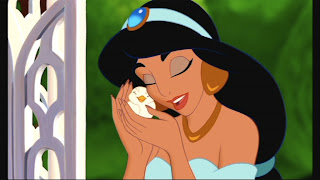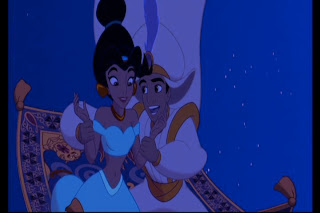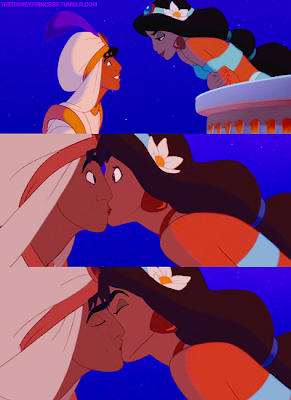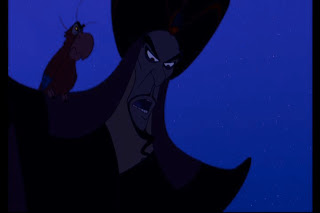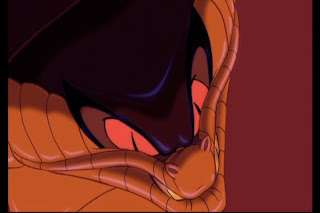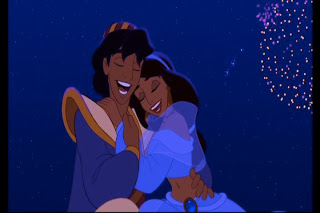We’ve well established that the Disney Renaissance includes some of the most beloved Disney films of all time for various reasons. As far as beloved and popular franchises go, very few Disney films (even those that make up the Disney Renaissance period) can touch Aladdin. The scope of this film goes far beyond the ninety minutes that made up Aladdin itself. If I had to name one film of the Disney Renaissance that had the most prominent presence in my childhood, I would definitely give that honor to the diamond in the rough.
While I did watch the film quite a bit on VHS, my exposure to it didn’t end there. Aladdin was everywhere when I was a kid. I had Aladdin action figures (the Cave of Wonders play set in particular was really cool. If you pressed a switch, you could cause a little panel to drop and plastic rocks would fall down, recreating the cave in sequence). Aladdin inspired a long running animated series of the same name on Disney Channel that I watched a lot. Aladdin (for better or for worse) was the film that started the whole Disney straight to video sequel trend. One year for Halloween, I even dressed up as Jasmine. It wasn’t my very favorite Disney movie (to be honest, it still isn’t), but it was definitely one that always made me laugh and made me happy when I watched it (to be honest, it still does).
 So why does Aladdin continue to have such broad appeal to this day? That question has multiple answers and it’s only fair that we cover each one. Let’s start with what I most enjoy about Aladdin: the fact that it’s funny. Aladdin stands out because it was Disney’s first straight up comedy. Yes, there were comedic elements in Disney films prior to this one, and yes, there are moments in Aladdin that could be described as tense, dramatic, and romantic, but the blood that keeps this film pumping is its humor. Even the few moments in Aladdin that were decidedly more serious in nature somehow had a lighthearted comedic tone underneath it. Take, for instance, the scene where the guards attempt to drown Aladdin and the Genie rescues him. What most performers would have played as a straight up tender moment between two people realizing that they’re friends, the Genie instead says: “I’m gettin’ kinda fond of you, kid. Not that I want to pick out curtains or anything.”
So why does Aladdin continue to have such broad appeal to this day? That question has multiple answers and it’s only fair that we cover each one. Let’s start with what I most enjoy about Aladdin: the fact that it’s funny. Aladdin stands out because it was Disney’s first straight up comedy. Yes, there were comedic elements in Disney films prior to this one, and yes, there are moments in Aladdin that could be described as tense, dramatic, and romantic, but the blood that keeps this film pumping is its humor. Even the few moments in Aladdin that were decidedly more serious in nature somehow had a lighthearted comedic tone underneath it. Take, for instance, the scene where the guards attempt to drown Aladdin and the Genie rescues him. What most performers would have played as a straight up tender moment between two people realizing that they’re friends, the Genie instead says: “I’m gettin’ kinda fond of you, kid. Not that I want to pick out curtains or anything.” What do you expect to happen when you mix Disney animation with Robin Williams? From the second the Genie first appears on screen (“Oi! Ten thousand years will give you such a crick in the neck!” may possibly be the greatest introductory line in the history of Disney animation) to his very final “made you look,” the audience is treated to one of the finest vocal performances ever done for a Disney film. Ron Clements and John Musker specifically created the role of the Genie with Williams in mind. It’s clear to see that they got way more than they anticipated when Williams was cast. He improvised so much during his recording sessions that they wound up with almost sixteen hours of material. That whole opening scene with the merchant was famously entirely improvised by Williams. In fact, the Academy turned down Aladdin’s script for a Best Adapted Screenplay nomination because of the number of adlibs Williams did. Williams has said before that Aladdin is probably the closest his standup has ever come to being documented on film.
What do you expect to happen when you mix Disney animation with Robin Williams? From the second the Genie first appears on screen (“Oi! Ten thousand years will give you such a crick in the neck!” may possibly be the greatest introductory line in the history of Disney animation) to his very final “made you look,” the audience is treated to one of the finest vocal performances ever done for a Disney film. Ron Clements and John Musker specifically created the role of the Genie with Williams in mind. It’s clear to see that they got way more than they anticipated when Williams was cast. He improvised so much during his recording sessions that they wound up with almost sixteen hours of material. That whole opening scene with the merchant was famously entirely improvised by Williams. In fact, the Academy turned down Aladdin’s script for a Best Adapted Screenplay nomination because of the number of adlibs Williams did. Williams has said before that Aladdin is probably the closest his standup has ever come to being documented on film.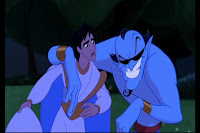
He brought something completely new and different to Disney. This wasn’t the kind of slapstick humor that had been the standard since the dwarfs’ antics in Snow White. Instead, audiences were treated to comedy that is very savvy and very current, courtesy of Mr. Williams’ never ending barrage of imitations and voices. The Disney tradition of giving their animated films a timeless feel went out the door when suddenly the likes of Jack Nicholson, Groucho Marx, Johnny Carson, Robert DeNiro, and Rodney Dangerfield began appearing in storyboards. The whole Disney canon opened up for parody in Aladdin: Sebastian (accompanied by a few bars of “Under the Sea”) makes a cameo, as does Beast among the Sultan’s toys. Genie even changes into Pinocchio, and sports a Goofy hat when he finally leaves Agrabah. Though I have yet to see it for myself, if you watch Rajah when he changes back from being a kitten into a full grown tiger, his face changes into Mickey Mouse’s for a few frames.
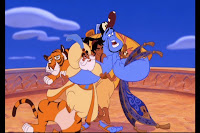
Though Williams’ comedic timing is the stuff of legend, he also manages to show his full range as an actor in this film as well. It’s often been said that comedians make the best dramatic actors because of how much conviction they display for acting out the absurd, if that makes sense. After all, Williams won his Oscar for his dramatic turn in Good Will Hunting. Here in Aladdin, he performs the (few) more serious scenes of the film with a great amount of emotional sincerity, such as when he is telling Aladdin that he really ought to be himself around Jasmine and his reaction to Aladdin telling him that he can’t set him free.
It would be really easy to write a whole blog entry just about Robin Williams’ turn as the Genie (and I’m not ruling that possibility out), but he is only one character in one of the largest ensemble casts ever amassed for a Disney animated feature: there’s Genie and Aladdin, of course, but there’s also Jasmine, Carpet, the Sultan, Abu, Rajah, Iago, and Jafar. That’s nine principal characters right there. One would think with that many characters the film would trip on its numerous dangling plot threads and/or that some of the characters might not be as well conceived as others. Aladdin, shockingly, does not suffer in the slightest from either of these problems. The story was handled quite masterfully and each one of the characters was brimming with so much personality that it was impossible for the audience not to feel an attachment for each one of them.
Fortunately, the cast was headed up by a remarkable lead. Voiced by Scott Weinger (his other famous role was as an actor on Full House), Aladdin had a lot going against him and I don’t just mean his circumstances depicted in the film. Disney princes don’t exactly have a reputation for being the most interesting characters in the film. The best ones complement their respective princesses and manage to fit in some heroics. The worst ones are little more than singing mannequins. A great portion of Aladdin’s success hinged on a male character –who is technically the first male not of royal descent to be paired with an official Disney princess- being able to carry the film’s action on his shoulders. Hmm, that means Disney would need to properly animate an incredibly complex character while still portraying him as sympathetic. Whatever would they do? This looks like a job for Glen Keane!
 It would have been so easy for them to simply create a good-looking male character that is confident, defeats the villain, and gets the girl before the credits roll. What the audience gets is a complicated and yet real Disney hero who is easy to relate to. Glen Keane creates a young man desperate to prove that he’s more than some lowly street rat. He goes about proving that he is worthy of the woman he loves by pretending to be something he is not, believing that his true self could never be good enough for Jasmine. He finally discovers what he is capable of when saves the day just by being himself. What is particularly brilliant about Aladdin is that he is less Prince Phillip and more Johnny Appleseed.
It would have been so easy for them to simply create a good-looking male character that is confident, defeats the villain, and gets the girl before the credits roll. What the audience gets is a complicated and yet real Disney hero who is easy to relate to. Glen Keane creates a young man desperate to prove that he’s more than some lowly street rat. He goes about proving that he is worthy of the woman he loves by pretending to be something he is not, believing that his true self could never be good enough for Jasmine. He finally discovers what he is capable of when saves the day just by being himself. What is particularly brilliant about Aladdin is that he is less Prince Phillip and more Johnny Appleseed. Bear with me a second. We’ve talked quite a bit on here about the Disney portrayal of male characters that don’t necessary use their strength to become heroes. Johnny Appleseed from Make Mine Music and Taran from The Black Cauldron are two good examples of such male characters, both displaying varying degrees of success. Here in Aladdin, the hero doesn’t employ brawn to achieve his goals. Aladdin is obviously not the strongest kid on the block; after all, the palace guards manage to overpower him. He isn’t the best-looking hero to emerge out of the Disney studio. He doesn’t have a fancy sword or a trusty steed like Phillip did. Aladdin doesn’t defeat Jafar by overpowering him; Aladdin defeats Jafar by outsmarting him. He tricks the Genie into getting them out of the Cave of Wonders, he manages to survive in the icy tundra, and he tricks Jafar into wishing to be a genie. While he might not be traditionally educated, Aladdin is incredibly intelligent and that proves to be one of his greatest strengths.
 His other strength would be his selfless heart. The filmmakers didn’t want to glorify being a professional thief, which is why they added the scene of Aladdin giving his bread to the hungry children. It was a perfect means of conveying the idea that Aladdin is a diamond in the rough. Perfect description for him, seeing as how Aladdin had to make a couple of mistakes before realizing his potential, symbolically chipping away at the rough until the diamond was visible to everyone. Best example of this is the ending. When all is said and done, and the Genie gives Aladdin the choice of becoming a prince again so that he can be with Jasmine, instead of living a lie, he does the right thing and sets the Genie free, possibly at the cost of losing Jasmine forever. I believe it’s important that the Sultan was there to witness this moment, seeing as how a beat later, he gets this look of conviction in his eyes and changes the law so that Aladdin and Jasmine could finally be together.
His other strength would be his selfless heart. The filmmakers didn’t want to glorify being a professional thief, which is why they added the scene of Aladdin giving his bread to the hungry children. It was a perfect means of conveying the idea that Aladdin is a diamond in the rough. Perfect description for him, seeing as how Aladdin had to make a couple of mistakes before realizing his potential, symbolically chipping away at the rough until the diamond was visible to everyone. Best example of this is the ending. When all is said and done, and the Genie gives Aladdin the choice of becoming a prince again so that he can be with Jasmine, instead of living a lie, he does the right thing and sets the Genie free, possibly at the cost of losing Jasmine forever. I believe it’s important that the Sultan was there to witness this moment, seeing as how a beat later, he gets this look of conviction in his eyes and changes the law so that Aladdin and Jasmine could finally be together.A lot of people (the animators included!) cite the Sultan’s final act revelation as being a tad too convenient, but I actually felt that it did work well in the story. If we pay attention to the Sultan’s very first scene showing him interacting with his daughter, his primary motivations for marrying Jasmine off are revealed. He’s not so much concerned about upholding the law, as he is about knowing that his daughter will be cared for in the way that she deserves to be cared for after he is gone. After witnessing Aladdin make the right and honorable decision by the Genie, the Sultan realizes that Aladdin is a good man that will care for his daughter far better than any prince, so he doesn’t hesitate to change the law. The late Douglas Seale was the voice for the Sultan, and he turned in a lively, enjoyable performance as a loving, frazzled, confused, but overall jovial father.
Scott Weinger turned in a great performance as Aladdin as well, especially considering that he had only been fifteen years old at the time he was cast. He has been the voice of Aladdin ever since then too, practically making a living on being a Disney character. Personally, I see no shame in that. Weinger didn’t provide Aladdin’s singing voice, though; that job belonged to Brad Kane, who was actually going to be Aladdin’s speaking voice as well until Weinger was cast. I had thought that this was the first time in Disney history where the voice actors didn’t sing their characters’ songs, but I was wrong. It turns out that Eva Gabor did not do her own singing in The Aristocats.
It is a good thing that he is such a strong character since Aladdin marks the only occurrence of a Disney princess appearing in a film in which she is not the title character. When the Sultan says the line, “her mother wasn’t nearly so picky,” there’s an underlying layer of humor there. There’s no way someone who looks like the Sultan could have produced a daughter that looks like Jasmine unless her mother was ridiculously, smokin’ hot. I’ve often said that the most physically beautiful Disney princess is Aurora and that the downright cutest Disney princess is Ariel, but if I were asked who I thought the hottest Disney princess, I would definitely give it to Jasmine. Her hair is so luscious, she’s not afraid to show off her awesome body (her best outfit, in my opinion, is the red one Jafar forces her to wear; it’s kind of like Jasmine’s slave Leia moment), and her face is just gorgeous. I especially love that her nose isn’t the typical tiny nose that most of the Disney princesses have.
 Fortunately, there’s more to Jasmine than her looks. Much, much more. I don’t know if she’s the most strong willed princess ever, but she’s definitely up there. I’ve said for both The Little Mermaid and Beauty and the Beast that the Disney Renaissance was a clear marker of the time feminism inserted itself Disney and made itself comfortable. Jasmine in particular is a princess by inner feminist can get behind. She goes toe to toe with Jafar at multiple points, she doesn’t let her father’s adherence to tradition dictate her life, and she is not impressed with Aladdin’s Prince Ali persona. Though she does have one notable damsel moment (the really scary hourglass), most of the time I find Jasmine fascinating and awesome. In today’s global political climate, I find it incredibly poignant that a young woman of Middle Eastern descent would refuse to conform to the will of the men around her. Resist Jasmine does; one of her best scenes is when she walks in on the Sultan, Aladdin, and Jafar talking about her marriage prospects and calling all of them on trying to dictate her future, outright that she is “not a prize to be won!”
Fortunately, there’s more to Jasmine than her looks. Much, much more. I don’t know if she’s the most strong willed princess ever, but she’s definitely up there. I’ve said for both The Little Mermaid and Beauty and the Beast that the Disney Renaissance was a clear marker of the time feminism inserted itself Disney and made itself comfortable. Jasmine in particular is a princess by inner feminist can get behind. She goes toe to toe with Jafar at multiple points, she doesn’t let her father’s adherence to tradition dictate her life, and she is not impressed with Aladdin’s Prince Ali persona. Though she does have one notable damsel moment (the really scary hourglass), most of the time I find Jasmine fascinating and awesome. In today’s global political climate, I find it incredibly poignant that a young woman of Middle Eastern descent would refuse to conform to the will of the men around her. Resist Jasmine does; one of her best scenes is when she walks in on the Sultan, Aladdin, and Jafar talking about her marriage prospects and calling all of them on trying to dictate her future, outright that she is “not a prize to be won!”At the same time, there is a gentle side to Jasmine as well, especially indicative with her interactions with Rajah, the caged birds, and giving that apple to the little boy in the market place. One of my favorite moments involving Jasmine comes at the very end after Aladdin has apologized for lying to her. Instead of getting mad or laughing cruelly as Aladdin feared that she might, she simply takes his hand and says, “I know why you did.” Why do I love this moment? Because of how much depth it gives to Jasmine. She’s aware of intimidating her title as a princess can be, and she really hates that it could cost her a chance at truly being happy. Jasmine is different from every other princess before her because she absolutely hates being a princess and just wants to be free to live her life.
 She also has a sense of humor. One of my favorite moments in the film is when Aladdin is saving her from Hamurabi’s code and is guiding her away under the guise of going to see the doctor. Jasmine has this great vacant look on her face as she greets a camel with a “hello, doctor, how are you?” I love how you can hear a bit of restrained laughter in Aladdin’s voice when he says, “no, no, no, not that one.” As Aladdin himself says, “She’s smart and fun and beautiful!”
She also has a sense of humor. One of my favorite moments in the film is when Aladdin is saving her from Hamurabi’s code and is guiding her away under the guise of going to see the doctor. Jasmine has this great vacant look on her face as she greets a camel with a “hello, doctor, how are you?” I love how you can hear a bit of restrained laughter in Aladdin’s voice when he says, “no, no, no, not that one.” As Aladdin himself says, “She’s smart and fun and beautiful!” Jasmine also marks the first time a princess using her feminine wiles against a Disney villain. This is a big, big, big first for Disney, considering that the company started with an innocent little princess running away from a Huntsman. Jasmine confronts the villain instead of running away and even goes so far to (unwillingly) kiss Jafar. Obviously, she is very much aware of her appearance and blatantly uses her sexuality to achieve a goal. If that’s not a sign of how much Disney has changed since the days of Snow White then I don’t know what is.
Jasmine also marks the first time a princess using her feminine wiles against a Disney villain. This is a big, big, big first for Disney, considering that the company started with an innocent little princess running away from a Huntsman. Jasmine confronts the villain instead of running away and even goes so far to (unwillingly) kiss Jafar. Obviously, she is very much aware of her appearance and blatantly uses her sexuality to achieve a goal. If that’s not a sign of how much Disney has changed since the days of Snow White then I don’t know what is.  |
| I'm with Al on this one. Ick. |
Even her voice has a sexy quality. At once it’s demure and breathy, and then another moment it’s strong and powerful. It’s a great voice that belongs to actress Linda Larkin. I’m going to be totally honest here. If I ever saw Linda Larkin in person, unless I heard her speak, I would never have guessed in a million years that she was the voice of Jasmine. For most of the Disney Princesses, it’s pretty clear that the animators drew some inspiration from the voice actors providing those lovely vocal chords. Jasmine has olive skin, brown eyes, and black hair; Larkin has fair skin, green eyes, and blonde hair. Mark Henn, Jasmine’s supervising animator, actually turned to another source for inspiration for her physical appearance: actress Jennifer Connelly and a photograph of his sister when she was in her teens.
Of course, Larkin wasn’t Jasmine’s singing voice. That duty went to esteemed Broadway actress Lea Salonga. Together with Brad Kane, they sang what is arguably the finest love song in the Disney canon. It was a collaboration between Alan Menken and Tim Rice. It won an Academy Award for best song. The members of UltimateDisney.com voted it the number one Disney song of all time. Of course, it is “A Whole New World.”
Why is it such an amazing song? At first glance, it is a song about how amazing it is to go around the world on a magic carpet. On another level, it is a song that beautifully describes how it feels to fall in love. One of my all time favorite DVD bonus features is from the Platinum Edition release of Aladdin when they showed the footage of Brad Kane and Lea Salonga singing “A Whole New World” for the first, though I have to say that it would be pretty awkward to sing such a romantic song with someone you only met about twenty minutes ago.
One of the defining features of the Disney Renaissance is the films’ inclusion of a show stopping romantic scene, created by a wonderful song with some truly memorable and great animation: for The Little Mermaid, it’s “Kiss the Girl,” for Beauty and the Beast, it’s “Beauty and the Beast,” for The Lion King, it’s “Can You Feel the Love Tonight,” and for Aladdin it’s “A Whole New World.” The montage of images that accompany the song ranks up there with the most romantic Disney moments of all time. I especially love the ending shot of Aladdin and Jasmine holding hands as Carpet paddles down the river.
The scene is capped off by one of the greatest Disney kisses of all time. I love the setup of Jasmine looking down at Aladdin from her balcony, and the expressions on their faces as they look at each other ring so true for anyone ending a romantic evening together. The saucy little smile Jasmine has on her face and the bedroom-y eyes both characters give each other lets the audience know exactly what they are thinking about. The way they are very slowly leaning towards each other lets us know that they are most definitely contemplating kissing each other. I guess Carpet thought that they were taking too long because he definitely speeds things along by giving Aladdin a sudden boost upwards, straight for Jasmine’s mouth. Their surprised eyes connecting briefly are great, as is the way in which they relax into the kiss. In the animators’ commentary on the Platinum Edition DVD, the animators declared this to be the sexiest Disney kiss ever. I don’t know if I would go that far, but as I always say, I would have to agree that it’s up there.
I love Carpet’s presence in this scene. Usually the more romantic moments in films are reserved for just the two people, but here there’s a third character offering a (silent) commentary. His pantomimes as Aladdin continues to weave a tangled web of lies are priceless. Carpet might possibly be my favorite supporting character because of how much emotion he is able to exude without a face or a voice. I love how he manages to kiss Jasmine’s hand without the use of lips. Randy Cartwright animated Carpet, and he literally animated a flying, expressive rectangle and nothing more. That elaborate, ornate pattern was added onto Carpet with the aid of a computer. The final product is absolutely amazing; I would never have believed that a computer had a hand in his creation if I hadn’t watched the making-of documentary.
Aladdin was the first film Disney had done in a very long time to have a distinctive “look” in everything from character designs to backgrounds. Specific geometric shapes defined the bodies of the character models. Animators were inspired by the s-curve that is so prevalent in Arabic calligraphy and applied that effortless curve to all of the characters, backgrounds, and effects animation found in Aladdin. Effortless to the audience, but not so much for the clean up animation department, which had to go over every single page of animation and apply that thick and thin curve, which is somewhat taken for granted as the film is being viewed. The result is some of the most refined animation Disney had done since Sleeping Beauty. For help in getting that curve down pat, the Genie’s supervising animator, Eric Goldberg, looked to the work of master caricaturist and cartoonist, Al Hirschfeld.
If there were one animator alive today who is a spiritual successor to one of the Nine Old Men, it would definitely be Eric Goldberg. He shares Ward Kimball’s sensibilities that animation should be stylized as opposed to being realistic. Just as it is really easy to be able to point out a Ward Kimball character because of how distinctively they look and move, it is really easy to point out an Eric Goldberg character. Animating the Genie was his very first gig with Disney and right off the bat he proved himself as a force to be reckoned with. Just as Alice in Wonderland was Kimball’s chance to shine, Aladdin is a showcase for Goldberg’s talent as an animator. After all, it takes some serious skill to keep up with someone like Robin Williams. With the Genie, he was not limited to just the scope of the world confined in Aladdin. The Genie was a character that allowed limitless possibilities for where the animators could take him. The one piece of advice Goldberg told his team of animators before they began work on the Genie was simply, “Have fun.”
Also notable is Aladdin’s use of computer animation. What started with a gilded ballroom in Beauty and the Beast has graduated to a number of memorable characters and a pulse-pounding cave in sequence. That really intricate design on Carpet would not have been possible without some digital aid. The tiger guardian of the Cave of Wonders was actually animated by hand initially by Eric Goldberg in order to give the computer animation team something to emulate before it was animated entirely by computers. Overall, the computer use in Aladdin is a mixed bag. That flight to escape the collapsing Cave of Wonders while thrilling looks archaic by today’s standards for blending computer animation with hand drawn. The Cave, though he is obviously a digital character, still manages to pull off convincing movements and emotions.
There’s no replacing hand drawn talent though. Though Aladdin is a sort of A Star is Born moment for Goldberg, that doesn’t mean that the other supervising animators were not in top form for this film. Glen Keane, as always, produced a resonant, heartfelt performance out of Aladdin, and Mark Henn brought both subtlety and passion to Jasmine, which is not an easy feat. For my money, though, this is the film where Andreas Deja truly hit his stride as an epic villain animator.
His job: supervise animation over Jafar. Deja’s last assignment had been Gaston, who was handsome, big, and muscle-y. Jafar is spindly like a spider’s leg, with an ape like jaw and a chin beard reminiscent of a corkscrew. Both are very different characters, both are very different kinds of villains, but both were carefully and thoughtfully animated. One thing that I absolutely love about Deja is the reverence he has for the Golden Age Disney animated film; he looked to Milt Kahl’s Brom as inspiration for Gaston, and for Aladdin, he sought out Marc Davis’ Maleficent as a source of inspiration for Jafar. Aside from gender and skin color, there are a plethora of similarities between the two characters. They both have bird sidekicks, they both wield magic through a staff, they both transform into giant scary animals for their respective films’ climaxes, but most of all, they are both characters that command attention in whatever scene they are in but are still quite isolated from the rest of the cast. The majority of Maleficent’s scenes revolved around her ranting and raving alone with only a raven to bounce off of. Jafar is similar in that most of his interactions happen with Iago. UltimateDisney.com users voted Jafar as the second greatest Disney villain of all time, just behind Maleficent. Coincidence? Not likely.
It’s a well-earned title because Jafar is pretty wicked. First of all, he’s a villain in a position of trust and power as a vizier to the Sultan, automatically granting him both power and influence but he wants even more power, which is never a good combination. He’s definitely got the ruthless thing down pat for wanting the Sultan to order Jasmine to marry him (ick!) and for referring to Genie as his “slave.” He’s also reminiscent of the classic comic book villains of old who would make bad puns in the midst of battle (“I’m just getting warmed up!” “Get the point” “Things are unraveling fast”), which might possibly be his most scary trait. Broadway actor Jonathan Freeman provided his voice and comedian Gilbert Gottfried lent his unmistakable, shrill pipes to Iago.
If Disney casts a Broadway actor in a role, they are probably expecting them to sing at some point, and sing Freeman does in a really twisted reprisal of “Prince Ali.” Which brings us to the unique situation regarding Aladdin’s soundtrack, in that there was not one but two song writing teams working on this film. Adapting the story of Aladdin into a Disney animated film had originally been Howard Ashman’s idea way back when he first did The Little Mermaid and if he and Alan Menken had not worked on Beauty and the Beast, it would have been their next project. As we all know, Ashman died before production of Beauty and the Beast was completed but he had managed to complete some songs for Aladdin. Unfortunately due to some drastic story changes, a lot of Ashman’s songs were either cut altogether or changed. The songs that survived the cut were “Arabian Nights,” “Friend Like Me,” and the first performance of “Prince Ali.” This left the soundtrack in a bit of a lurch, as it was incomplete. For the first time since Howard’s death, Menken would have to collaborate with another songwriter.

Bringing in another lyricist could have spelled disaster for the film. Would the new songs manage to connect cohesively with the songs they already had? Was it possible for anyone else on the planet to write lyrics that could be in the same league as Ashman’s? None other than Tim Rice answered the call.
He rose to the challenge like a true professional and succeeded in droves. The songs that Rice wrote are very much in style with the original Ashman songs, so much so that I would never have known two different men wrote them if I hadn’t been informed so. Obviously, “A Whole New World” is gorgeous, and the reprisal of “Prince Ali” is especially well done considering that Rice was writing from an Ashman song. He would later have to write in the Ashman style again for Broadway, when he wrote additional songs for the stage adaptation of Beauty and the Beast. “One Jump Ahead” is amazing and has that frenetic lyrical quality that Ashman was known for.
“One Jump Ahead” is actually one of my favorite scenes in Aladdin. I love the Tex Avery scenarios that Aladdin finds himself in as he works his way through Agrabah to evade the guards. Before the Genie appears, some of the film’s biggest laughs come from this scene. My sister’s favorite part of “One Jump Ahead” is the B.B.W. who picks up Aladdin and sings, “Still I think he’s rather tasty.”
My favorite part of “One Jump Ahead” is when Abu manages to get a hold of a sword and brandishes it like an extra out of Raiders of the Lost Ark as the guards briefly cower in fear (“He’s got a sword!”) before the head guard barks, “You idiots! We’ve all got swords!”
Hard to believe that a reprisal of such a fun song would morph into one of the most poignant scenes in the film, isn’t it? It does though. Just as “Part of Your World” gave the audience a glimpse into Ariel’s soul and dream, “One Jump Ahead (reprise)” gives the audience a chance to see that fervent, passionate look in Aladdin’s eyes that only Glen Keane could grant. There’s a charming ignorance about Aladdin’s beliefs that all of his problems would vanish if he were rich and lived in a palace. There’s a great use of irony that the next scene shows Jasmine turning down yet another suitor, proving that money and status don’t really solve problems and can actually create a few new ones.
Is it any surprise that Aladdin became as big as it did? Animation, songs, voice talent, story; this film has it all in spades. Because of how strong a film Aladdin turned out to be, it really surprised me when I learned the kind of problems surrounding it. What kind of problems you might ask? Well for one thing, about midway through production after the first story reel of the film was completed, Jeffrey Katzenberg stated that he didn’t like the film and told them to start over from scratch, without moving the scheduled release date. The mood of the animators was so dismal that they have since christened that day “Black Friday” (even though it didn’t occur on a Friday).
The story that Howard Ashman had originally envisioned for Aladdin wasn’t working and a lot of story elements had to be dropped and/or reworked. Originally, Aladdin’s mother was still alive and a large part of the film’s emotional story hinged on her. Aladdin also had three friends, two genies, and a magic ring. Jafar was initially envisioned as a hot head that was constantly losing his temper while Iago was cool and British with an even temperament. Possibly the biggest change was with Aladdin himself: his design was much shorter and younger than the buff older version we see in the final film. The reason for the change? He didn’t look like someone Jasmine would fall for; as Katzenberg put it, “He’s Michael J. Fox, she’s Julia Roberts. Make him Tom Cruise.”
Even after the film was released there was some controversy. Initially in the song “Arabian Nights” there was a lyric that went, “Where they cut off your ear if they don’t like your face.” Not too shockingly, some Arab Americans took some offense to that line and it has since been changed to, “Where it’s flat and immense and the heat is intense.” We do need to pause on the subject of Aladdin’s Middle Eastern setting, considering the relevance of the area to the way our world functions today. There’s no question that Islam is present in Aladdin; there are several references made to Allah. As such, there have been complaints about Aladdin’s lack of actors from the Middle East providing voices for this film. Bear in mind, that as was the case with The Rescuers Down Under, the Disney version of a culture from across the world is one that has had a number of American values and ideas pressed upon it, throwing cultural authenticity out of the window. As stated by Dr. Ali Behdad, the associate professor of English at UCLA, regarding the Genie in the original story, “there is no desire – on the part of the Genie – to become free, but in the Disney version, his fantasy is to be free and I think that too is an American value that is projected onto this character.” The Genie isn’t the only character to receive an American makeover. Like I said before, a huge chunk of Aladdin’s story hinges around a female character refusing to conform to a masculine society.
There were also some problems going on behind the scenes. Robin Williams did this movie at a Union rate on the condition that his character would not be used in more than twenty-five percent of the film’s advertising, which if you ask me is a fair deal. If you couldn’t tell from the poster I selected to headline this entry, Disney did not exactly uphold their end of the bargain, which ticked Mr. Williams off a good bit. It damaged his relationship with the studio for many years, and it didn’t mend until Jeffrey Katzenberg was fired and a public apology was issued to Mr. Williams. That is why Robin Williams reprised his role as the Genie in Aladdin and the King of Thieves. Though the rift between Williams and the Studio has supposedly been mended, I do speculate that there is still some unresolved tension. If you look on iTunes for the Aladdin soundtrack, all of the songs are available for purchase, except for two, which are listed as “album only”: “Friend Like Me” and “Prince Ali,” both of which were songs that Williams provided the primary vocals for. Also, Williams was the only living cast member who did not return to do an interview for the Platinum Edition Aladdin documentary.
All that being said, Aladdin was a tremendously successful film for Disney. In the U.S. alone it earned $217 million, while the worldwide box office garnered over $504 million. Understandably, this is a film that has left a legacy that has never gone away. Aladdin has a very prominent theme park presence. Aladdin and Jasmine are two popular face characters available for greeting in Adventureland over at the Magic Kingdom and in Morocco over at World Showcase in Epcot, as well as being frequent participants in parades. Jafar is a prominent member in the Disney Villains line, and even makes an appearance in his giant snake form in the Hollywood Studios nighttime standby, “Fantasmic!” “The Magic Carpets of Aladdin” is a fun Aladdin-fied version of “Dumbo the Flying Elephant” that appears in both Disney World and Disneyland Paris. Also in Disney World, “The Enchanted Tiki Room: Under New Management” features Iago teaming up with The Lion King’s Zazu to add a more hip coat of paint to the classic Disney attraction.
Arguably the most famous attraction inspired by the film is found over on the West Coast of the United States, at Disney’s California Adventure Park, where Aladdin has been adapted for the stage into Disney’s Aladdin: A Musical Spectacular, a forty five minute show which plays at the Hyperion Theater. I have had the privilege of seeing this show for myself and I do have to say that it truly is spectacular. Carpet flies over the audience, the spectacle of the “Prince Ali” sequence is brought to life, but not too surprisingly, the Genie was the biggest crowd pleaser and garnered the greatest laughs. Following in the tradition that Williams set for the character, the Genie’s dialogue changes constantly to reflect what is going on right now in pop culture, even though the rest of the show is scripted. When my sister and I saw the show a few years back, when Aladdin freed him, the Genie said, “So this is what it feels like to be Paris Hilton. That’s hot.” Obviously, we saw the show around the time of the Paris Hilton jail controversy. Cementing my theory as a fact that Disney uses the theme park stage shows as a way to gauge public interest in a full production, a musical stage production of Aladdin will see a debut in Seattle later this year.
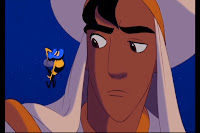
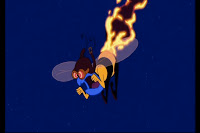
 Is Aladdin the funniest Disney film ever or do you reserve that title for another movie? What are your favorite Genie moments? A couple of mine include: “Look at me from the side, do I look different to you?” the black and white Groucho Marx impression, the zombie inspired impression of Peter Lorre, the magic carpet flight attendant, “C’est l’amour,” the bee buzzing romantic advice into Aladdin’s ear (“Punctual!”), and “rick ‘em, rack ‘em, rock ‘em, rake, stick that sword into that snake!” As for that canon couples poll I proposed a (long) while back, I realize that February has indeed come and gone, but I am not about to let your couple nominees go to waste. I actually thought of something a bit more fun to do with your OTPs. What exactly? I’m not ready to say yet. You’ll just have to stick around until after I write about Tangled to see what I have in store.
Is Aladdin the funniest Disney film ever or do you reserve that title for another movie? What are your favorite Genie moments? A couple of mine include: “Look at me from the side, do I look different to you?” the black and white Groucho Marx impression, the zombie inspired impression of Peter Lorre, the magic carpet flight attendant, “C’est l’amour,” the bee buzzing romantic advice into Aladdin’s ear (“Punctual!”), and “rick ‘em, rack ‘em, rock ‘em, rake, stick that sword into that snake!” As for that canon couples poll I proposed a (long) while back, I realize that February has indeed come and gone, but I am not about to let your couple nominees go to waste. I actually thought of something a bit more fun to do with your OTPs. What exactly? I’m not ready to say yet. You’ll just have to stick around until after I write about Tangled to see what I have in store.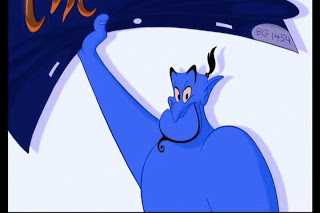 |
| Made you look |




















